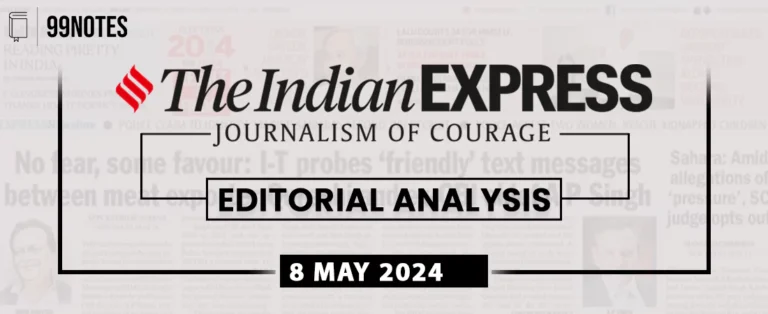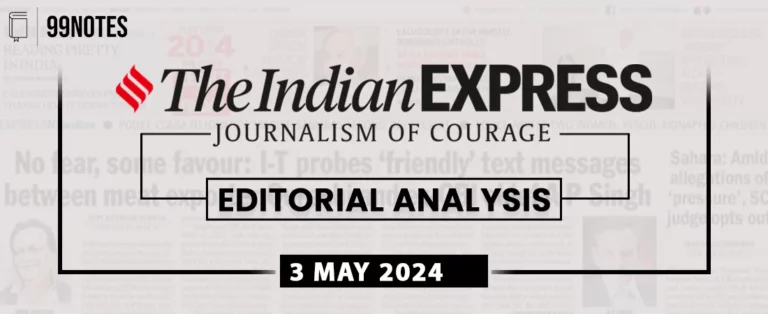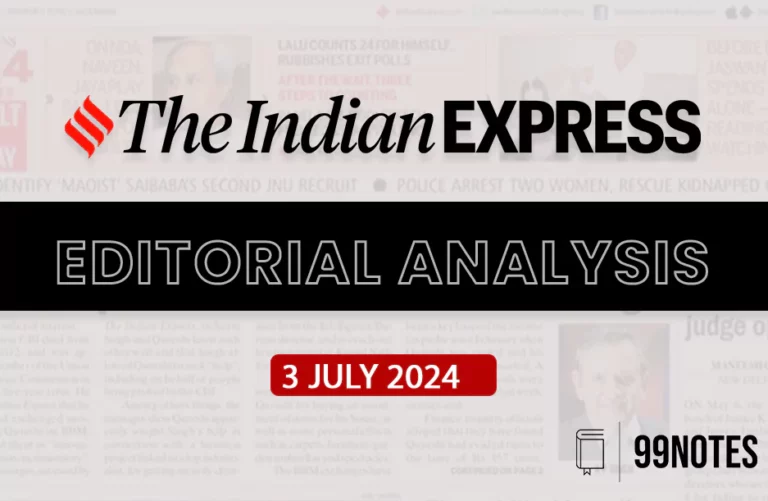12 Jan 2024 : Indian Express
Indian Express
12- January-2024
1. THE SECOND CHANCE
| Topic: GS2 – Polity – Executive This topic is not much relevant in the context of Prelims but more for Mains in the context of legal aspects related to remission, emphasizing the role of the Supreme Court and the appropriate authority for deciding remission applications. |
| Context: |
|
Understanding Remission: A Reformative Opportunity:
- Remission, which is obtained by good behaviour, prisoner activities, and labour, gives inmates the chance to shorten their term without changing the type of punishment.
- It comes from the idea that imprisonment should serve as a means of rehabilitation, enabling inmates to participate in reformative activities and maybe be released before serving out the entirety of their sentence.
- Inmates are eligible for early release when the total number of days they have completed in remission is subtracted from their sentence.
Challenges in Applying Remission Policies:
- It is difficult to apply remission laws to people convicted of violent crimes like rape and those given life sentences.
- Although lifers may be eligible for remission following a minimum 14-year sentence, there are differences across states and offences.
- The length of the minimum prison sentence for horrible crimes like rape and murder determines the likelihood of remission, depending on how serious the offence was.
Inconsistencies Across States: A Normative Challenge
- States’ remission policies differ, posing procedural and normative issues.
- Offence-based exclusions and extended terms of jail eligible for certain offenders generate normative issues regarding the rehabilitative purpose of prisons.
- There is procedural examination of the composition of review boards and their decision-making procedures, raising doubts about whether remission requests are consistent with the rehabilitative and reformative objectives of correctional facilities.
Reformation and Overcrowded Prisons: Urgent Transformation Needed
- Remission, parole, and furlough are examples of leave measures that are essential to a prisoner’s reformation and reintegration into society.
- However, a major obstacle to their potential for transformation is the overcrowding, securitization, and overload of Indian prisons.
- The urgency of the transformation required by the prison system’s crisis highlights the need to reevaluate policies that exclude people and to think more deeply about the ability of prisons to support reform.
Conclusion:
- A more thorough examination of the condition of Indian jails and their function in the rehabilitation of offenders has been prompted by the Bilkis Bano case, which highlights the significance of clear and comprehensive remission rules.
| Landmark Cases of Remission: |
| Laxman Naskar v. State of West Bengal (2000): In this case, SC stipulated the factors that govern the grant of remission namely: Whether the offence is an individual act of crime without affecting the society at large? Whether there is any chance of future recurrence of committing crime? Whether the convict has lost his potentiality in committing crime? Whether there is any fruitful purpose of confining this convict any more Socio-economic condition of the convict’s family. Epuru Sudhakar v. State of AP (2006):
|
| PYQ: Instances of President’s delay in commuting death sentences has come under public debate as denial of justice. Should there be a time limit specified for the President to accept/reject such petitions? Analyse. (200 words/12.5m) (UPSC CSE (M) GS-2 2014) |
| Practice Question: Discuss the constitutional and socio-economic considerations involved in the assessment of remission applications and reflect on the implications of the verdict for the reformative goals of imprisonment in the context of Indian criminal justice and penal system. (250 words/15 m) |
2. Open up the playing field
| Topic: GS2 – Governance – Interventions for development in various sectors This topic relevant for both Prelims and Mains in the context of the provisions of the Telecommunications Act 2023, its implications, and the broader aspects of the telecommunications industry. |
| Context: |
|
Provisions for Safety Standards and Public Emergencies: Balancing Power and Privacy:
- The Act brings significant reforms, such as contentious clauses that give the government a great deal of authority over public crises and safety standards.
- Although the Act improves right-of-way, fund utilisation, and spectrum allocation flexibility, it is criticised for possibly violating public privacy by not holding governing officials sufficiently accountable.
Promotion of Competition: Addressing Challenges in the 5G Landscape:
- Addressing issues in the 5G landscape, the Act highlights the need for attracting investments.
- Major service providers’ publicly declared capital expenditures are motivated by roll-out goals; nevertheless, maintaining investments in 5G startups continues to be difficult.
- Allowing new competitors and opening the market to them can encourage more investment and innovation in the sector.
Technology Neutrality of Spectrum Use: Equitable Access and Infrastructure Unbundling
- The Act protects spectrum use technology neutrality, which is commendable, but it does not adequately reflect this idea in the way communication services are provided.
- In order for new companies to effectively compete, they must have commercial access to infrastructure that is both non-exclusive and non-discriminatory.
- The Act need to embody the essence of infrastructure unbundling, encouraging input and output equivalency to ensure equitable competition.
Emphasis on Right of Way: Facilitating Infrastructure Buildout
- The Act emphasises the value of right of way and recognises the necessity for an atmosphere in business that reduces infrastructure expenses.
- Nonetheless, major resource generation is needed to finance fibre infrastructure, which is necessary for the switch to high-quality digital applications.
- In order to create a competitive investment environment, the government should support the development of infrastructure in both rural and urban areas through the Universal Service Obligation Fund (USOF).
- Regulatory Convergence: Integrating Telecommunications and Internet
- As the Act merges two previously independent acts, it signals the demand for regulatory convergence.
- A single, cohesive vision is necessary since the fragmented approach to internet and telecoms is becoming outdated.
- Broadcasting, licencing, standards, skill development, and governance should all be included in regulatory convergence to provide a comprehensive response to the rapidly changing digital environment.
Conclusion:
- With the Telecommunication Act 2023, India’s telecom sector will have a revolutionary opportunity to navigate the obstacles posed by evolving technology.
- In order to achieve the digital revolution that the Act envisions, it is imperative that we embrace regulatory convergence, facilitate infrastructure development, and foster healthy competition.
| What is the Status of the Telecom Sector in India? |
|
| Practice Question: Discuss the key provisions and implications of the Telecommunication Act 2023. (150 words/10 m) |
For Enquiry

13 Feb 2024 : Daily Current Affairs Quiz

13 Feb 2024 : Daily Answer Writing

13 Feb 2024 : Daily Current Affairs

13 February 2024 : The Hindu Editorial Notes PD

13 Feb 2024 : Indian Express Editorial Analysis

13 February 2024 : PIB Summary for UPSC

12 Feb 2024 : Daily Current Affairs Quiz

12 Feb 2024 : Daily Answer Writing

12 Feb 2024 : Daily Current Affairs

12 Feb 2024 : Indian Express Editorial Analysis
Daily Quiz 13 Feb 2024 : Daily Current Affairs Quiz 13 Feb 2024 : Daily Quiz…
mains answer writing 13 Feb 2024 : Daily Answer Writing Mains Answer Writing
13-February-2024
Q1) With the help of a map, show major ocean currents of the world….
Daily Current Affairs 13 Feb 2024 : Daily Current Affairs Daily Current Affairs
13-February-2024- Top News of the Day
1. Indian Navy Personnel Released from Custody…
Feb 2024 The Hindu 13 February 2024 : The Hindu Editorial Notes PD The Hindu Editorial
13-February-2024
1. A global alliance to bridge the gender equity gap
Topic:…
Indian Express 13 Feb 2024 : Indian Express Editorial Analysis Indian Express Editorial Analysis
13-February-2024
1. A science for us
Topic: GS2 – Governance…
feb 2024 PIB 13 February 2024 : PIB Summary for UPSC PIB Summary for UPSC
13-February -2024
1. Union Minister G Kishan Reddy inaugurate regional centre…
Daily Quiz 12 Feb 2024 : Daily Current Affairs Quiz 12 Feb 2024 : Daily Quiz…
mains answer writing 12 Feb 2024 : Daily Answer Writing Mains Answer Writing
12-February-2024
Q1) “Water scarcity threatens economic and social gains…
Daily Current Affairs 12 Feb 2024 : Daily Current Affairs Daily Current Affairs
12-February-2024- Top News of the Day
1. Great Indian Bustards give Nandyal a…
Indian Express 12 Feb 2024 : Indian Express Editorial Analysis Indian Express Editorial Analysis
12-February-2024
1. CLASSROOM VS COACHING
Topic: GS2 – Social…




